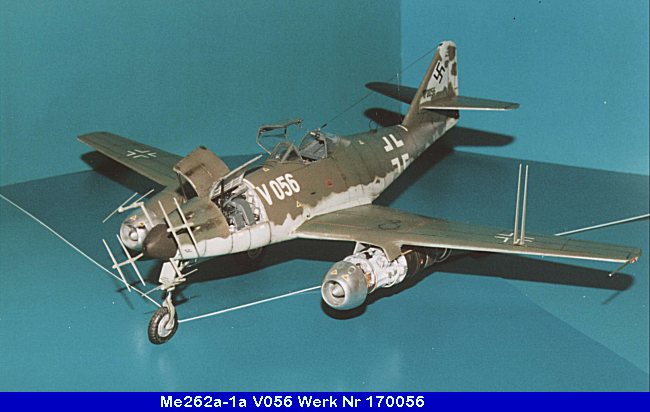
Dragon 1/48 Me-262A-1a Nachtjäger
|
KIT # |
5515 |
|
PRICE: |
(AUD)$65.00 |
|
DECALS: |
Prototype V056, werke No. 170056 |
|
REVIEW & |
|
|
NOTES: |
Decal Rating: Excellent - 10/10 (despite the lack of swastikas!) |

|
HISTORY |
The Messerschmitt Me262 was the world’s first operational jet fighter to go into service against Allied fighter and bomber aircraft during WWII. It entered service in the autumn of 1944 and the aircraft's high performance in air battles over Nazi Germany became a great concern for the Allied air forces. The Me262 began it’s life as Me262V1 but initially was powered by a single Jumo210G inverted-vee liquid cooled reciprocating engine due to the late delivery of the intended jet engine, BMW P.3302 (later designated BMW 003). The year was 1940.
By July 18, 1942 the engines had been changed to the Junkers Jumo 004 turbojet, following problems with the BMW unit, the aircraft designated Me262V3. This aircraft still incorporated a tail wheel and it was not until Me262V5 had made it’s maiden flight on June 6, 1943 did the basic shape evolve. This aircraft had fixed nose gear, as the retraction mechanism could not be installed in time. The first prototype to have retractable nose gear was Me262V6, Werk Nr130001 and coded “V1+AA”. This aircraft was also the first to have the ability of having the four 30mm MK108 cannons installed in the nose, although it was never armed with the weapon. The standard production configuration of the Me262 was now established.
The pilots who flew these fabulous jet fighters, rather than let them fall into the hands of the advancing Russian forces, doused them in fuel and set them alight. They were also destroyed in their factories, along with the technologies, in an attempt to stop them being used by the liberation forces. Between these activities and the results of the Allied bombing efforts very few of these phenomenal aircraft have survived. Those that did were quickly taken as the spoils of war.
The Me262A –1a Nachtjager was borne out of the frustration by the Luftwaffe for the Mosquito night fighters. In November 1944 the experimental night fighter V056, Werk Nr170056 was built using a FuG218 “Neptune VI” radar unit mounted in front of the radio equipment bay in the rear of the aircraft. The antennae were mounted on the nose of a Me262A-1a. It was also used to test the FuG226 “Neuling” radar, during February 1945 and made the role as the prototype of the Me262B-1a/U1, the definitive two-seat night fighter. It was eventually written off after being seriously damaged during a heavy landing accident.
Oberleutnant Kurt Welter piloted V056 during the combat night tests and achieved no less than five kills with two Lancasters and three Mosquitos shot down. His final tally for the war is said to have been 64 with 54 night victories, of the latter two were the aforementioned Lancasters and 28 of them were Mosquitos earning him the nickname “Mosquito Killer”.
This particular aircraft had the standard four fixed 30mm MK108 cannon mounted in the nose, had a top speed of 870 km/hr and was powered by two Jumo 004B turbo-jet engines delivering 900kg of thrust per engine. It had a service ceiling of 11,400 metres (approximately 37,400 ft).
|
THE KIT |
Overall this kit has well defined recessed panel lines and all the detail to keep even the most fastidious of modelers happy, myself included. This is why this kit has been built as an out of the box (OOB) using the photo-etched parts supplied. The only additions added by myself were the extra electrical cables in the cockpit and the brake lines on the front and main undercarriage.
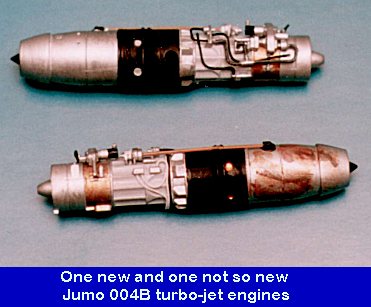 Dragon has supplied two engines with the kit that allows you to display the model with engines fully cowled or open. These were upgraded by including the plumbing and electrical wiring. One engine was covered and the other displayed sans cowlings.
Dragon has supplied two engines with the kit that allows you to display the model with engines fully cowled or open. These were upgraded by including the plumbing and electrical wiring. One engine was covered and the other displayed sans cowlings.
|
CONSTRUCTION |
The kit assembled well and, armed with a plethora of information from modelers and enthusiasts alike most pitfalls were avoided, aside from those created by the builder! I was forewarned about problems associated with gluing the fuselage halves together that result in an inverted “V” forming around the joint and used templates from Aero Detail No. 9 to bolster the interior and keep the correct profile. Similarly I ensured that the leading edges of the wings were appropriately filled so that the wing root was correctly positioned. This will be explained later in this review. Being aware of the fit problems that can be found in Dragon kits makes life a lot easier, well easier anyway. The cockpit goes together very well and has a ton of detail. Using the references the cockpit was painted in Model Master RLM66, Schwartzgrun, with the instrument dials painted flat black and various knobs and switches painted red and yellow depending on their function. The instrument dials were likewise colour coded according to their functions. The Revi gunsight was painted Tamiya Flat Aluminium. The seat belts were supplied as photo-etch and, as they are steel, needed extra work to bend them into shape. These were painted olive green with the buckles painted silver.
The Cockpit
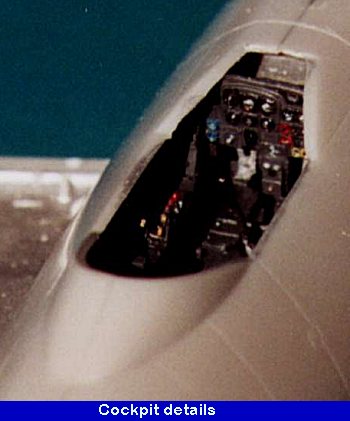
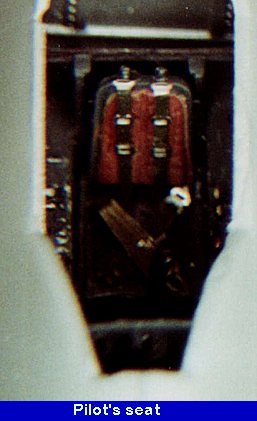
The cockpit is a tub arrangement that fits inside the fuselage with the underside clearly visible from the wheel wells and therefore it needs to be painted. It was given a coat of Tamiya XF16, Flat Aluminium and allowed to dry. The interior walls of the fuselage were similarly painted in Flat Aluminium and side details painted in flat black and blue, in the case of an oxygen bottle.
The control stick was augmented with a cable, as was the Revi gunsight, although the latter was attached after the airframe had been painted and prior to installing the front windshield. A word of caution about the gun sight, it requires the hole in the instrument panel to be enlarged slightly to accept the pin that holds the sight. It is a matter of choice whether you decide to open the hole or reduce the thickness of the pin, but in order to get it to slide in without snapping it off, one must be done.
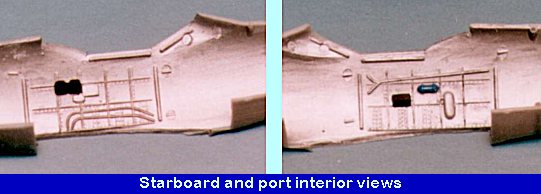
Once the whole thing was dry and the fuselage was connected the cockpit was installed, along with the forward and rearward bulkheads. The canopy was attached after all painting had been completed and is discussed below.
The Fuselage and Wings
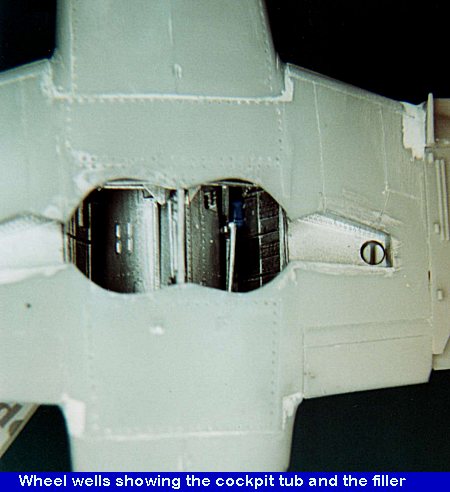 Forewarned is forearmed! I had managed to get hold of an article entitled “Trimaster/Dragon/DML Me262’s in 1/48 How to Build Them and not go Mad” by Jamie Davies (no relation), who is a member of the IPMS here in Australia. Contained within this article are explicit instructions that help the modeler avoid the pitfalls of gluing the wings and fuselage together. It explains the innocent look of the fuselage join prior to gluing with no hint of the dangers for the unwary. I had an excellent reference in the form of Aero Detail No. 9 Messerschmitt Me262A with scale drawings at 1:48 and 1:72, complete with templates at various points along the fuselage. I used two of these templates at the rear of the cockpit and employed a clear plastic ruler as braces. Once the two templates had been cut they were sanded down and glued into position, after test fitting of course. The result is the correct profile, which is a flat, slightly convex shape from the rear of the wheel wells. Although I do now have to go and get another clear plastic ruler!
Forewarned is forearmed! I had managed to get hold of an article entitled “Trimaster/Dragon/DML Me262’s in 1/48 How to Build Them and not go Mad” by Jamie Davies (no relation), who is a member of the IPMS here in Australia. Contained within this article are explicit instructions that help the modeler avoid the pitfalls of gluing the wings and fuselage together. It explains the innocent look of the fuselage join prior to gluing with no hint of the dangers for the unwary. I had an excellent reference in the form of Aero Detail No. 9 Messerschmitt Me262A with scale drawings at 1:48 and 1:72, complete with templates at various points along the fuselage. I used two of these templates at the rear of the cockpit and employed a clear plastic ruler as braces. Once the two templates had been cut they were sanded down and glued into position, after test fitting of course. The result is the correct profile, which is a flat, slightly convex shape from the rear of the wheel wells. Although I do now have to go and get another clear plastic ruler!
I glued the lower wing into position after fitting the cockpit tub and the internal details for the main undercarriage. This area of the kit is almost entirely composed of metal photo-etch and needs to be completed and installed in the lower wing and allowed to cure. The area where the main lower wing fits into the fuselage needs some filler and some reshaping to conform to the fuselage profile. I used Milliput grey along with superglue and then re-scribed the panel and rivet detail lost during the sanding process.
Once this had set I then added the upper wing halves. This is where there are two glaring problems that I had been warned about:
1. If you check each fuselage side there is a raised section where the upper wing half is to join. Positioning the upper wing against this shows that the wing root shape does not quite fit and therefore needs some filler. If you let the two wing surfaces join then the upper wing is too low on the fuselage;
2. The second is that if you join the upper wing exactly on the fuselage, as per the raised join mark, then there is a significant gap between the two wing halves just a little outward on the leading edge of the wings.
My solution was to apply filler and superglue at the same time and apply gentle pressure until both halves had bonded. This ensures that the upper half fits against the fuselage and it’s lower counterpart. Make sure that you remove the combined filler and superglue before it has completely cured, thereby saving much grief during the sanding process. This process also allows the correct dihedral to be maintained. You don’t need to be Octopus Man to achieve this just employ some patience and, if you can get a third hand, apply some accelerant to the superglue.
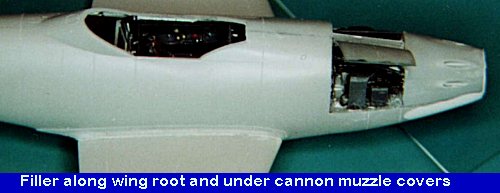
The rear tail planes were attached and the whole assembly is now ready for the undercarriage. Again I used superglue as the medium to provide instant bonding and thereby preventing the tail planes from drooping.
Undercarriage
The kit supplies rubber tyres and I decided to leave them as they were. The main undercarriage and front wheel struts are painted in Model Master RLM 02, Grun, although references have the option of flat aluminium. I used Bare Metal Foil, Chrome for the oleos of each strut and added some plastic covered wire to simulate the brake lines for each wheel strut. In addition the kit supplies the wheel well actuating rods and like the oleos, these were given the Bare Metal Foil treatment.
During the connecting part of this stage I came to a small amount of grief. The wheel wells, as supplied, are very detailed and most of the components are photo-etch. This provides a very realistic wheel well for the main undercarriage but that is where the problem arose. When it came time to attach one of the hydraulic rams for the main strut to the wheel well, the hole in the photo-etch was found to be too small, or more correctly, the hydraulic ram connecting pin is too thick. It is shaped like a “D” but will require some paring to get it to fit easily. The rod is also a little too long and should be reduced to achieve a perfect fit. I found this out too late, despite Jamie’s advice, and had bent the rod and scraped off my hard-earned metal foil job. By this time it is too late without major corrective surgery, so it is staying that way!
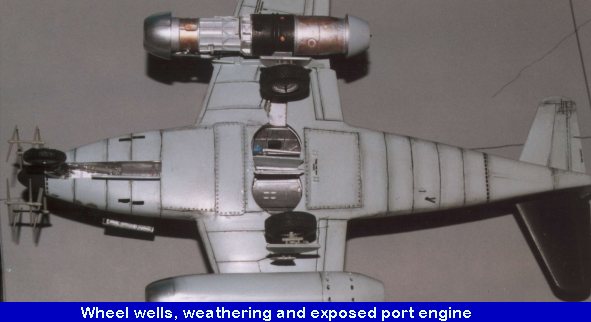
In a similar manner the main wheel well doors that hinge off the centerline of the aircraft do not quite fit into their respective holes – they do now, but only after much swearing and gnashing of teeth – ain’t modeling a relaxing hobby?
The outer doors are attached to the main oleos and their placement is relatively easy to accomplish. Both the outer and inner doors, plus the front and main undercarriage struts were attached after the aircraft had been painted. This has become the ritual to prevent fiddly bits being snapped off by clumsy galoots such as myself!
Armament
Dragon supply a very detailed gun bay, which has the option of panels that may be displayed as open or closed. I elected to display the cannon bay opened and used the references to give the bay a little more realism. The MK 108 cannons are stacked two above and two below, the latter being stepped towards the outer edge of the aircraft. This allows the expelled casing chutes to sit alongside each other and minimize the space required. I cut slots in the floor of the cannon bay pan, as these are visible from the openings in the lower fuselage.
The cannons are supplied separate from the barrels and these are pushed through the upper fuselage against the cannon bodies, which protrude through the front bulkhead. I drilled out the barrels and opened the upper fuselage holes to accept them.
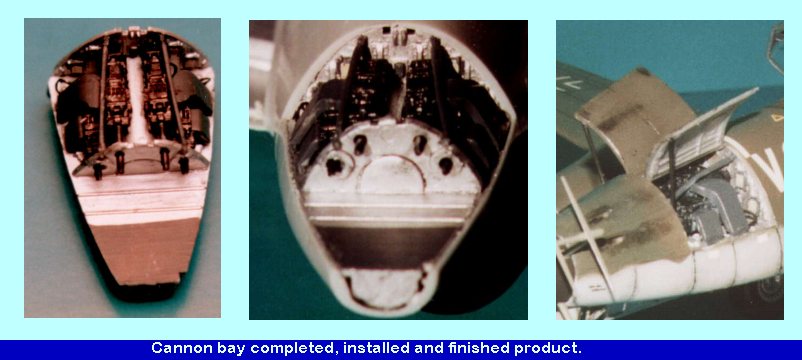
Small diameter copper wires were attached to each gun and painted black. These wires were the electric controls for the cannons. The cannons themselves were painted in Tamiya X10, Gun Metal and the ejected shell chutes were painted Model Master, RLM66 Schwartzgrun. The floor and walls of the cannon bay were painted Tamiya XF16, Flat Aluminium. Details on the rear wall were painted an off white to simulate the instruction labels for the cannon maintenance. The guns themselves were dry brushed with Flat Aluminium for highlights.
The inside of the cannon bay doors were painted Flat Aluminium and the bracing rods across the top of the bay were painted Schwartzgrun. The doors are held open by two stays, one on each side of the fuselage.
Although the kit allows the placement of the “Winkingersciff” racks under the forward fuselage I elected to leave them off. These units were designed to hold a bomb or drop tank on each rack and were positioned either side of the nose wheel well. The box art shows V056 with a pair of drop tanks on these racks, which were painted the same colour as the underside of the aircraft, RLM76,
Hellblau.
|
PAINT & DECALS |
The Spray Painting Phase At the time of spraying the upper camouflage I did not consider the closeness of RLM81 and RLM82, but now that the model is finished has become a point for reflection. The colours are very close with little contrast under normal light conditions. I would, in retrospect, have chosen to lighten RLM81 to give a better contrast between the two colours. Don’t get me wrong I think the effect is great and probably very close to the originally painted aircraft colours. Perhaps for the model it would have been a better effect to have a greater contrast between the two. You be the judge. The aerial is attached to the back of the rear canopy by means of a hook. I cut a paper staple and bent it to shape and used superglue to connect it to the rear canopy immediately behind the leading edge. The aerial was then constructed out of invisible thread and a loop made for the canopy connection. A hole was drilled into the tail fin and another just forward of the fin slightly offset to the port side top of the fuselage. This second hole is for another cable connected to the main aerial. I used a blob of superglue for the insulators and then painted the cable gunmetal.
This kit gives decals for one particular model, the test bed aircraft used for the various radar options. There are two options presented in this kit for V056 Werk Nr170056 and each has a slightly different colour scheme. One has the entire fin and the starboard tail plane painted black, using the FuG218 “Neptune VI” radar, and the other has just one tail plane painted black, FuG226 “Neuling” radar. I chose the latter as this has the two blade antennae on the port wing.
This is quite a complex scheme with the underside painted in Model Master RLM 76, Hellblau and the upper sections being sprayed with a combination of RLM81 and RLM82. Not so complex I hear you say, well not until you look at the boundary between the upper and lower surfaces. Here the boundary is indistinct with patches of both colours being sprayed over the RLM76, Hellblau. I chose to use the photocopier to enlarge the painting diagrams to create a template and, by using rubber glue, connected it to the fuselage leaving the edges free to give a graded boundary. The tail fin is predominantly RLM76, Hellblau and has patches of RLM81, using the photocopying technique allowed me to spray a nice effect.
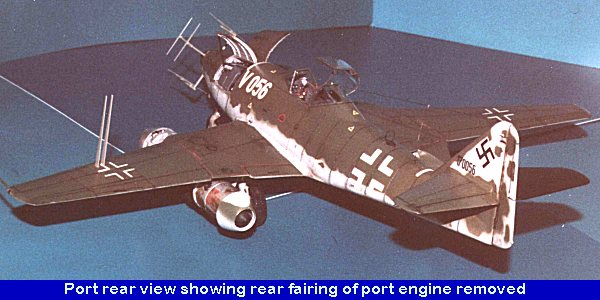
I had also decided to leave the bare engine off the wing attachment until all spraying had been completed. Once the full colours had been applied the aircraft was sprayed with gloss in preparation for the decals.
For the first time I had decided to use the many pre-cut masks that are available on the market and I chose to use the Eduard Express Mask series for the Me262A (set number XF48007). I found that they fit well to the canopy and made life easier…. perhaps I should have either pressed harder or let them stay on the frame a longer time before painting the frames. When I removed them I found that the paint had bled under the masks in some parts. Oh well. Live and learn!
Weathering was achieved using a mild detergent based water wash with artist watercolours. These were lightly painted into the recessed panel lines and allowed to bleed along their lengths. Once the lines had dried I used a cotton bud (Q tip, if you will) to remove the excess from overzealous applications.
The Canopy
This has been given a little special attention, as the amount of detail on this part is quite exquisite. The kit supplies photo-etch for the handle, located on the top of the canopy, release lever, rear bracing and a wire brace used when the canopy is opened. The starboard side of the canopy has a rod that fits into another photo-etch piece located under the starboard cockpit ledge, which has a hole at either end for the rod. This cockpit ledge fit so well into the fuselage that it has required no glue to hold it in place! The ends of the rod need to be carefully pared to allow then to rotate freely in the holes in the photo-etch, or open up the holes – your choice.
Another word of caution, one that I had been forewarned about but chose to ignore, the font cockpit windshield has a slight gap at the front. This is not large, and I ended up filling it with PVA glue, it would have been preferable to use a piece of plastic card before spraying the fuselage.
The rear canopy was painted with Model Master RLM66, Schwartzgrun on the inside and Model Master RLM81, on the outside. The hole for the canopy brace wire was drilled and it was glued to the airframe after the rear cockpit shelf was installed.
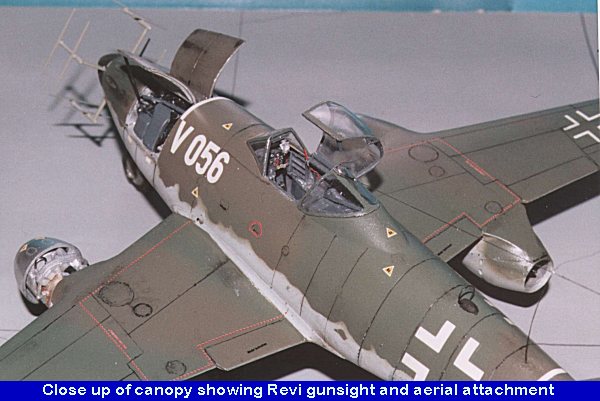
The Decals
The decals are very good and quite comprehensive. No special tricks in getting them to sit right, with little complex adhesive surfaces to overcome. I used Model Master Decal setting solution and did not suffer any silvering of note. This included the polished metal surfaces for the Jumo engine intake covers. I used the reference Aero Detail No.9 to check the correct positioning of the fuel numbers and various stencils.
The only decal missing out of the set is the swastikas. I know that some manufacturers are not keen to display such symbols on box art or on the instruction sheets as they may be seen as sympathizers to a political regime that struck fear and loathing into the minds of people the world over. I am not about to condone the politics, as this is neither the purpose of this site nor my viewpoint. However, I think that in these days of liberalism it should be left up to the individual as to whether or not they are going to portray an historical piece of machinery, as some manufacturers are keen to point out in their disclaimers. Ok, enough of my personal gripes. Suffice to say that there are no swastikas included in this kit.
The lack of the “crooked cross” may be due, in part, to the tail fin being painted black on one example, and may have been an oversight for the other. I have tried to find a reference photo of V056 showing the swastika on the tail, without any luck. However, in all cases where the tail fin is painted other than black a swastika is shown. One of my side-view plans clearly shows this with V056 displayed, so I decided to put them on. I used the Aeromaster decal set of German swastikas and crosses. The swastika is nearly always displayed at 45 degrees, making it sub parallel to the leading edge of the tail fin.
Once all the decals had been fixed and allowed to dry the aircraft was sprayed with Revell Clear Satin and the model dirtied up. All potential breakable bits were now added to the aircraft such as the canopies, aerials and antennae, plus the Pitot tube and clearance lights.

|
CONCLUSIONS |
This kit went together very well despite the fit problems with the wings and the fuselage joins. If you are pre-warned about potential problems it makes the job that much easier. For this I have Jamie Davies to thank for his excellent piece about constructing these kits. It should also apply to the Revell Me262A, as the kit appears to be a re-box of the Dragon kit. REFERENCES If you would like your product reviewed fairly and quickly, please contact
me or see other details in the Note to
Contributors.
The final model has turned out better than I expected although there are some niggling things with regards the weathering along the panel lines. I never seem to be able to get pre-shading to look quite right and usually resort to re-engraving the panel lines to expose the pre-shade. This is fraught with problems as the lines are never the same as before you start. Some of you seem to have perfected the technique from the reviews seen on this site; I am still on the steep slope of the learning curve in this regard. This model is no exception.
I have purchased the Revell offering and have decided to use the Verlinden upgrade set for the Me262A, along with the Eduard photo-etch set for the same kit. I will present that as a review in due course.
Messerschmitt Me262 Aero Detail No. 9, Publisher Dai Nippon Kaiga Co., Ltd. 1993
ISBN: 4-499-22624-4
The Luftwaffe Profile Series No. 1
Messerschmitt Me262 Griel, Manfred; A Schiffer Military History Book ISBN: 0-88740-820-6